Military analysts anticipated a substantial display of advanced Chinese weaponry at the September 3 parade in Beijing marking the 80th anniversary of victory in WWII, and were not disappointed. This article will review the significance of the weapons displayed in terms of the balance of military power and draw some conclusions regarding U.S. plans for a conflict with China.
Military parades in Beijing are designed as dual messages. Domestically, they symbolize national unity, technological progress, and Party legitimacy. Internationally, they are acts of deterrence signaling: visual statements that China can deny access, strike far, and survive counterattack. By presenting not only weapons but their enabling systems, such as VLS decks and mobile launchers, the PLA reveals its doctrinal modernization as much as its hardware. The qualitative signal is that China is no longer catching up; it is innovating in domains where it can impose costs and risks on superior adversaries. The following areas of military capability were showcased in the Beijing military parade.
Strategic Missiles and Hypersonics
Among the most striking revelations were the DF-17 hypersonic glide vehicle (HGV) and the DF-41 intercontinental ballistic missile. The DF-17 is the world’s first operationally deployed HGV missile, designed to penetrate missile defenses with unpredictable maneuvering at very high speed. The DF-41, road-mobile and capable of carrying multiple independently targetable reentry vehicles (MIRVs), demonstrates the PLA’s determination to modernize its nuclear deterrent. Together, these systems elevate China’s strategic credibility and complicate any adversary’s missile defense planning.
DF-17 Hypersonic Missile
Anti-Ship and A2/AD Weapons
China also paraded its DF-21D and DF-26 ballistic missiles, often described as “carrier killers.” These weapons are designed to hold U.S. carrier strike groups at risk within the first and even second island chains. Coupled with advances in targeting and surveillance, they present a formidable anti-access/area denial (A2/AD) challenge. Qualitatively, this shifts the maritime balance, undermining the assumption that U.S. naval forces can operate unchallenged in the Western Pacific.
DF-26 Ballistic Missile
Airpower Modernization
The air component of the parade underscored the PLA Air Force’s leap forward. J-20 stealth fighters flew in formation, a visible reminder that China now fields a maturing fifth-generation fleet. While still numerically smaller than U.S. F-22 and F-35 inventories, the J-20 symbolizes an important shift: China is no longer only imitating Western designs but refining its own. Reports suggest that prototypes of the J-35 naval stealth fighter are in advanced development, signaling that China’s carrier aviation will soon incorporate stealth capabilities. This airpower modernization gives the PLA a credible long-range interdiction and maritime strike arm.
Chinese fighter jets: J16, J20, and J35
Naval Power and VLS Revelation
One of the subtler but highly significant elements revealed at the parade and in its supporting media was China’s vertical launch system (VLS) technology. Although entire destroyers cannot be paraded, the PLA showcased models and deck mock-ups of its Type 055 destroyer, including close-up footage of its large universal VLS cells. The Chinese VLS cells are more versatile than the smaller U.S. Mk-41 system, and thus can launch more capable long-range surface-to-air missiles, land-attack cruise missiles, and even hypersonics. Because this standardized VLS is now common across China’s surface fleet, it provides enormous flexibility: ships can be reconfigured by payload rather than design. The qualitative impact is significant — greater magazine capacity, adaptability, and firepower concentrated in fewer hulls.
Chinese Type 055 Warship
Unmanned and Emerging Systems
The parade also highlighted the PLA’s advances in unmanned systems. The GJ-11 Sharp Sword unmanned combat aerial vehicle (UCAV) was displayed, representing a stealthy long-range strike platform. Drone swarms and electronic warfare UAVs point toward China’s embrace of ‘intelligentized warfare,’ where artificial intelligence and automation play a central role. These systems multiply reach, resilience, and survivability, allowing the PLA to project power at lower cost and with less risk to personnel.
Chinese Reconnaissance and Attack Drones
China’s Emerging Lead
The military hardware on display at the parade indicates that China has overtaken U.S. weaponry in several key areas. Although the U.S. still dominates in other categories, China is mounting a powerful challenge.
The prospects for the U.S. to regain the military technology lead in all areas where China is ahead are dubious for several reasons. China’s enormous population and extensive educational system provide a larger pool of engineers. In 2024 China graduated approximately 1.4 million students with engineering degrees. In the same year, the U.S. added 127,000 university-trained engineers. This human capital advantage is also reflected in research leading to patent applications.
Faced with ballooning deficits, the U.S. will struggle to increase its already massive defense budget, but China, with a lower debt to GDP ratio, can keep building up its forces with fewer budgetary constraints. Moreover, the performance of U.S. defense contractors is hobbled by perverse incentives and inadequate government oversight, so the U.S. wastes much of the money it spends on defense contracts. China’s ability to overtake U.S. defense technology in multiple areas while spending less indicates superior government management of weapons development.
Conclusion
The Beijing parade revealed more than weapons; it revealed a coherent doctrine. China’s emphasis on hypersonics, road-mobile ICBMs, ballistic anti-ship missiles, stealth fighters, universal VLS cells, and unmanned platforms underscores a posture of deterrence by denial. The PLA is crafting an arsenal designed not for global dominance but to prevent U.S. and allied intervention in its near seas. This qualitative transformation marks China as a peer-level deterrent actor, reshaping the security environment of the Indo-Pacific.
The U.S. no longer holds a broad qualitative edge in weaponry to offset China’s geographic and quantitative advantages. In many significant areas of weapons development, China has overtaken U.S. capabilities, and this disparity is likely to widen. Faced with these developments, U.S. policy makers appear to be reaching the conclusion that the window for a successful military conflict with China has closed, and that the strategy of using defense of Taiwan as a casus belli is a dead end. We should all welcome this unexpected hint of sanity in the chaos of Washington foreign policy.
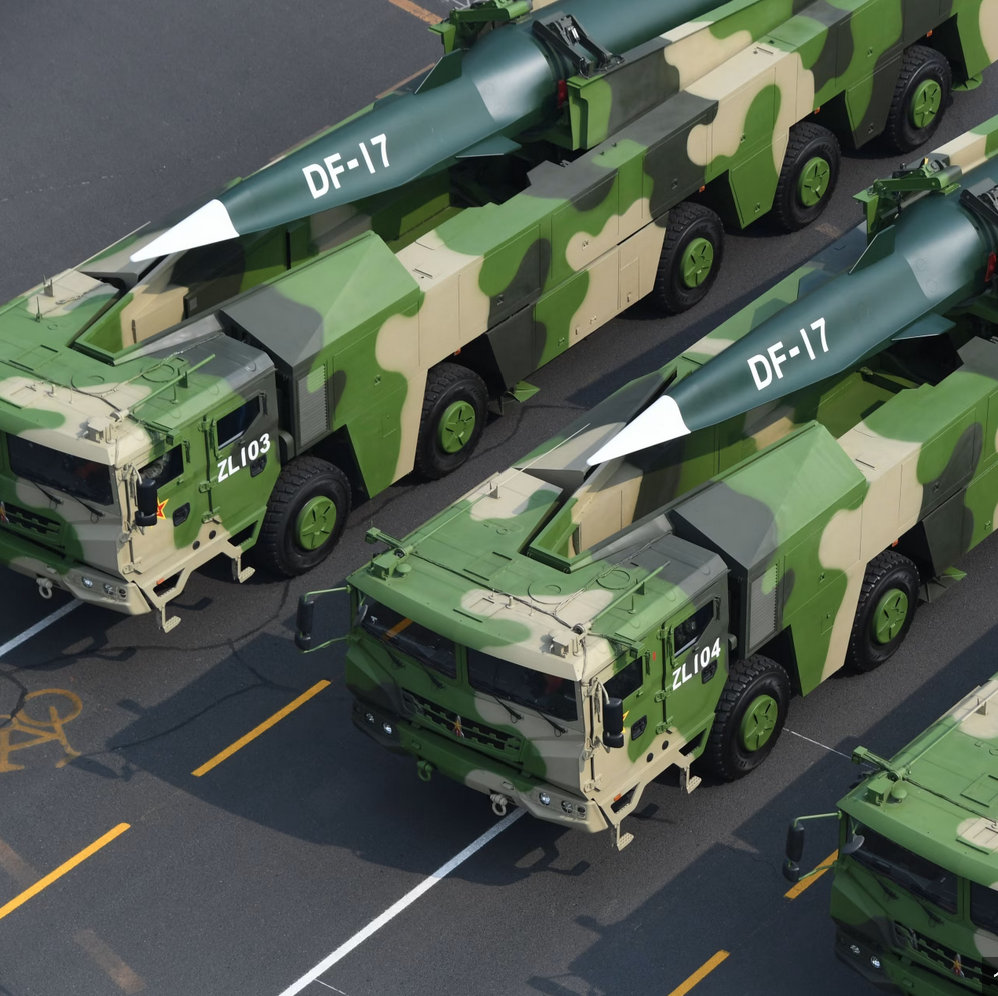
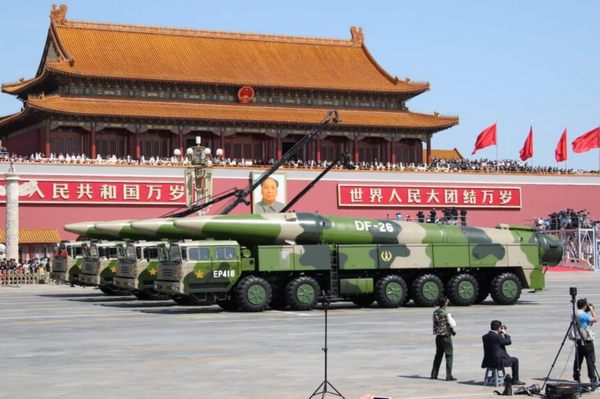
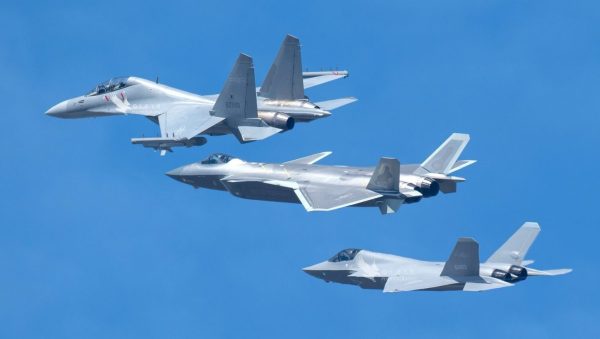
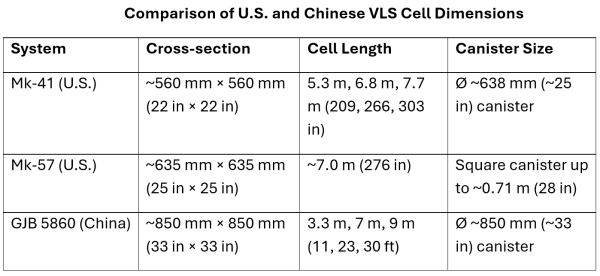
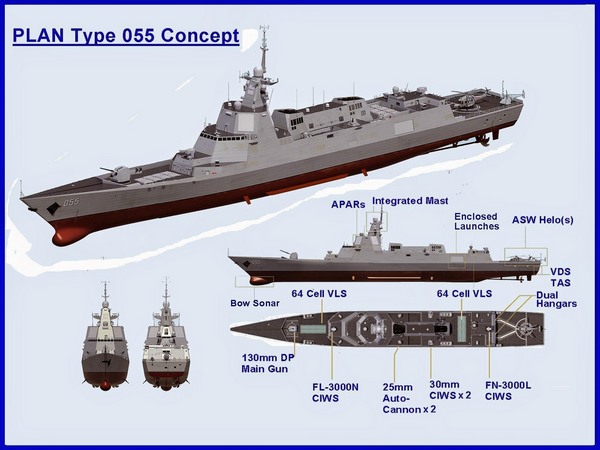
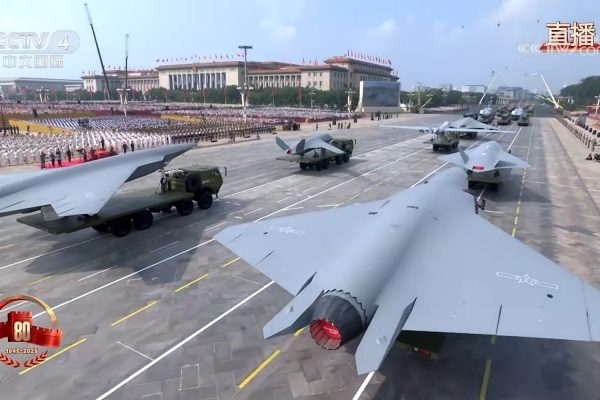
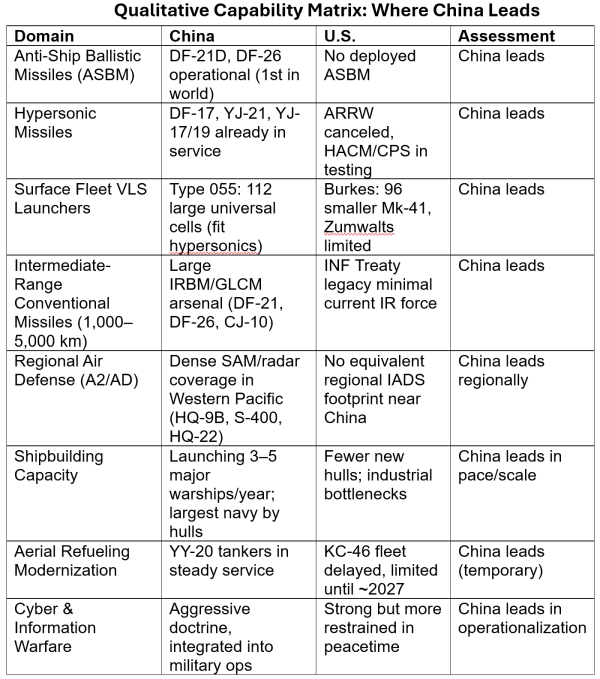
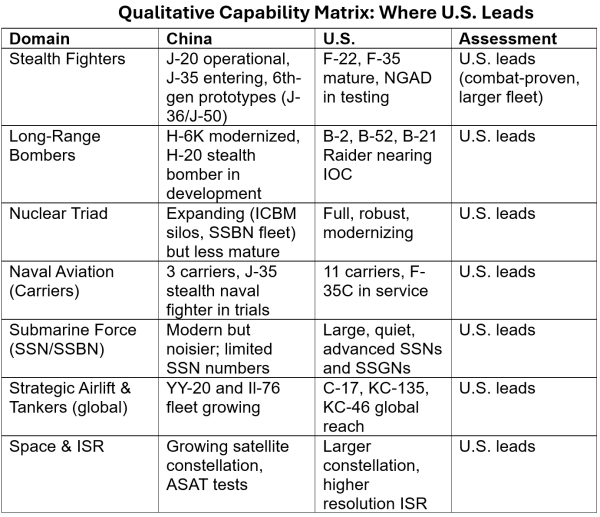



Quite impressive. So is this why the Trump administration is signaling a retreat from China and a refocusing on the Western Hemisphere? (Poor us.) Even that level of common sense seems impossible to find in our elites. Double Down and Golden Dome is the more likely direction.
There are still efforts to set fire to everything around China.
>>> We should all welcome this unexpected hint of sanity in….
The funny part is that the PLA have never really tried to hide these weapons—they were developed in plain sight of US spy satellites and stories publicly released in the Chinese equivalent of “Jane’s Defence Weekly.”
Like everything China-related, this event was years, decades in the making…
Did it really take a parade for the DC deciders and sycophantic media/pundits/think tank to notice? I guess that the answer is yes.
it really did, many people noticed that the pizza stores in DC were extremely busy when the parade was airing (https://www.pizzint.watch/)
and of course Mr. Trump watched as well and became well aware of what a farce the US parade looked like after he stayed up to watch it too
But even now on Youtube (like in the video linked at the start of the article), you can find Americans coping that it’s all plastic and fake. It appears America has taken on the role of Lu Xun’s Ah Q (https://en.wikipedia.org/wiki/The_True_Story_of_Ah_Q)
Thanks for the links: two things both interesting and new to me.
I suspect it was for the elucidation of the U.S. and global gen pop who are not generally familiar with the output of ” US spy satellites and stories publicly released in the Chinese equivalent of “Jane’s Defence Weekly.” I for one was duly impressed and will henceforth be encouraging my USian grandchildren to choose Mandarin as their second language. How does one say “Can’t we all just get along?” in Mandarin?
Mandarin, Japanese, Korean are all *very* difficult languages (different semantics/word order, verb usage, script, etc.)
Unless any kids are very motivated and want to make China-related stuff a big part of their lives, a peer Chinese person (say an employee at a multi-national corp) will speak better English than an American trying to speak their US-education-system-Mandarin. A random Chinese person in China will have more chances to practice English than a random American person in America who wants to practice Chinese.
Knowing basic Mandarin is helpful when in the countryside or C-tier cities. Even in “B-tier” cities, anyone with semi-regular contact with non-Chinese will know passable English (say Chonqqing versus A-tier Shanghai).
From a purely utilitarian POV, for most people, fluency in Spanish is more useful year-round (unless someone has an itch to work in Tianjin). IMO. YMMV
Mandarin, Japanese, Korean are all *very* difficult languages (different semantics/word order, verb usage, script, etc.)
Add the other South-East Asian languages to the list, as well as a truly major difficulty: some of them (especially Vietnamese and all varieties of Chinese) are tonal languages — you have to get the “ear” for them at a really young age, otherwise it is extremely hard to learn pronouncing and understanding them correctly.
Thanks. N=1, poor hearing put an insurmountable barrier between the French language and my tongue.
I hear that Western Slavic languages are actually generally harder to learn than East Asian ones (from my multilingual colleagues.). The tough thing about Chinese is the pronunciation, but I’m told that, once you figure things out, it’s fairly straightforward, at least in Mandarin (my friend in Taiwanese academia (he’s an American whose writings has been occasionally featured on NC in the past.) gave up trying to seriously learn Southern Min–the dialect of Fujian/Zhejiang/Taiwan regions–apparently, much more complicated than Mandarin, pronunciation wise.) While the ideographs seem daunting, they are fairly logical and relatively easy to figure out once you get the basics, at least for the commonly used few thousand characters.
Grammatically, Chinese is very simple, sometimes ridiculously so (e.g. lack of past tense, for example)–although that can cause issues since you need to pay close attention to the context to figure out what the other person means (I’m told this is true also with Russian as well?). Korean and Japanese are, well, a bit more convoluted gramamtically (I think I can speak of them both at the same time–they have identical, and I really mean identical grammar structure): they have a lot of nuances that mean slightly different things even if they translate identically to English or Chinese. BUT, unlike Chinese, they really mean what they mean without context dependence in most occasions.
Russian has past, present and future tense.
https://www.lesjeunesrussisants.fr/conjugaison/documents/THE_BIG_SILVER_BOOK_OF_RUSSIAN_VERBS.pdf
I meant contexts being more important than what is literally being said.
Correct me if I am wrong, but the tones in Chinese seem very sharp (clearly defined) and so the trick is learning how to say them. In Thai, they are subtle and hard to hear.
My understanding is that that is true in Mandarin, but South Chinese dialects are subtler.
> Mandarin, Japanese, Korean are all *very* difficult languages
> (different semantics/word order, verb usage, script, etc.)
There is an important point that is too often overlooked in discussions of this sort. In fact, no language is in and of itself easier or more difficult to learn than any other language. Hundreds of millions of children from Abkhazia to Zululand demonstrate this on an ongoing basis.
What you presumably mean to say is ‘Mandarin, Japanese, Korean are all *very* difficult languages for an adult native speaker of English‘. The degree to which another language is easy or hard to learn depends primarily on how similar to or different from your own language — syntactically, phonologically, etc. — it is.
Yes. Growing infants and children hear the sounds and cadence of their cultural language every minute of their lives. They learn how to make the appropriate sounds over many years. They develop a nuanced understanding of meaning as they age.
An adult American trying to learn a foreign language (of any kind) will take more time and effort than most can give. (That’s why many hispanic couples, who can, will teach their offspring both English and Spanish from the start.)
A first thing to remeber is that a large amount of military equipment developed in peace time never lives up to the hype. Because when war come it develops differently than expected, weapon system conceots have holes that were never considered.
Secondly, it was nit very impressive that all of these small automated vehicles were in thr back of trucks. It didn’t scream confidence in them working on the day.
There seem to be two camps that have formed around this parade. One that goes “this is all fake crap that won’t work” and another that is almost giddy eith excitement over how good all this equipment is. And there is very little evidence to back either. These systems should be taken seriously and assessed seriously. Neither dismissed as rubbish or uncritically accepted as succesful and ground breaking.
The political message of this parade was far more important than anything else. And remeber what sun tzu said “when strong act weak, when weak act strong”.
Plus, a lot of parade equipment are “fake,” even when they are not. The Russians sent 10 M-4 Bison bombers for 6 loops in one of their parades (in early 1950s, I think), to give the impression that there were more of these around than there were. Plus, the parade did not indicate how flawed the M-4s were as bombers–too short a leg for a strategic bomber, which is why they lost out to the turboprop powered Tu-95 Bears. But M-4 did look cool and futuristic by the contemporary standards.
As I remember that led to the Americans panicking in response and developing counter measures to an aircraft that failed in it’s designed purpose.
Of course there are also practical reasons for looping kit at parades. It’s very expensive and time consuming to get have it all there. A bit cheaper to loop it around.
I’ve spent a bit of time trying to find any demonstrations of any if this kit snd there is just about nothing. China isn’t the only country developing laser based anti missile and anti drone weapons. America has some already. Britain is installing them on tanks and soon on warships. Now will china develop better ones? Quite possibly. Will it be able to produce more of them? Certainly. But equally their attempt could fail. Or when it comes to an actual war the whole laser idea could prove to be a dud.
Think of all the equipment designed and built before WW2, and then how much of it was quickly repalced due to inherent flaws that were discovered when fighting began.
The Chinese anti drone lasers have been used both in Iran and during the SMO in Ukraine. Simplicus had put a video in an article a few weeks back. https://simplicius76.substack.com/p/sitrep-81325-pokrovsk-breakthrough?utm_source=post-banner&utm_medium=web&utm_campaign=posts-open-in-app&triedRedirect=true
Scroll to the bottom of the article. Chinese media has demonstrations of some of those robot tanks, dogs and drone ships. The rest I agree that there isn’t publicly available demonstrations.
But the real star of the show was the last weapon, the DF-5C. It significantly elevates China’s nuclear deterrent.
Britain can’t make a seaworthy vessel, let alone mount usable weapon on it. Those that “America has some already” are probably as good as British ones.
At least the Chinese are not shy or apologetic of cribbing friend and foe alike.
The caption could have just as well read:
SU35, SU57 and F35 in home match kits.
Serious question as this is well above my pay grade. Are the tech platforms/operating tech systems the same?
Functionally similar US jets.
Chinese avionics SW has several advantages over MIC SW! Beside a huger number of STEM grads.
If they do military avionics SW like they do DeepSeek, their systems are tested and work at significantly less cost!
One area both PRC and Russia applied faster than the west is Gallium Nitride strata for chips. This allowed higher powered (e.g. drive tiny receive/transmit modules in AESA antennas) applications in the tiny space which affect aircraft systems electronic performance.
US is catching up? F-35 is destined for a new radar, if they can deglitch the SW.
No. They look, and operate, similarily because same laws of physics apply to everyone.
The Chinese fighter designations are short for 歼击机, meaning fighter aircraft, “specifically the first ideogram 歼(Jian). What makes things a bit funny is that Chinese fighters used to be (may still be true) called F-X if it’s for export and J-X if it’s for domestic use–thus, J-7 was the Chinese built variants of MiG-21 used by the PLAAF and F-7 was the export version. If they still follow this practice by the time J-35 becomes avalable for export, it’ll be called F-35 (and J-35 is the Chinese response to F-35, with similar looks and capabilities, except for the VTOL capability, which they wisely dropped, for now…)
The Russian Avangard has been deployed since 2019.
One may notice that the lettering on the equipment is part of the message.
It is written “DF-17” in large latin letters, for western consumption, and not in chinese ideograms.
(h/t to an astute observer on X)
your random median Chinese person has basic knowledge of the Latin alphabet.
but ya, the PLA wanted to make it bloody obvious for the dummies in DC
just saying
This used to be the practice for Imperial Japan, too–and this was a regime that looked very askance at use of foreign loanwords. (the dead giveaway that a bunch of characters were visitors from the future to WW2 era Japan in a manga series that I read was that they were calling rifles “rifuru,” the direct import from English that became popular after WW2, rather than 小銃 (shochu)). The catch was and still is that Latin alphabet is far simpler than Chinese characters (and a lot of “Japanese” is Kanji–i.e. Chinese characters).
Chinese military equipment often uses latin letters and arabic numbers for identification purposes. Because they are much easier to see at a distance.
In combat, you won’t be reading letters on the incoming/outgoing missile. That being said, much easier to see at a distance is important for tactilcal markings, like the famous Russian “Z”.
So I guess that the US Navy using China’s coastline as their own personal parade ground all these years didn’t really work out over the long term. Now any warship from the US or one of its allies sailing near Taiwan can really only do so under China’s sufferance.
Weapons and technology are important, however, neither obviated Napoleon’s observation that the “moral is to the material as 3 is to 1.”
I suspect the US v PRC materiel “competition” is edging to the PRC, considering the locations of potential conflict.
The moral needs some thought.
Chinese, as do Russians, study war over thousands of years of sources. Sun Tzu wrote 2500 years ago.
PLA generalship in the great civil war was superior to need. PLA generals in Korea were effective and lost to huge US “mass”, effective logistics, and superior technology, maybe Napoleon has a use case here?
Russian generals are quite up to tilting against NATO strategy, ISR and operational plans Kiev executing using NATO technology. Russian generals beating a trillion dollar a year war machine……?
US generals, depend on vast, overbearing material superiority, but have not won since 1945. Aside Israel has not beat Hamas in 23 months, Hizbolah been active for 40 years and is dormant….
US planners have to worry the plucky, nuclear armed proxy in Pyongyang.
Maybe PRC/PLA will allow US to keep parts of the third island chain…. East of Midway.
Correction: DF-41 is an old system, what was shown was the previous unknown DF-61.
Of the missile systems shown, the most impactful is actually the YJ-19 which is a hypersonic scramjet which is much harder than “regular” hypersonic ballistic missiles as they fly lower and have shorter detection times due to the Earth’s curvature.
Not mentioned: new type 100 tanks (contrast with the US’s new M10 booker that was immediately cancelled), anti-drone lasers and microwave weapons, and anti-drone missile trucks with 96 (!) micro-missiles (compare with US avenger platform with 8 stingers).
I am not competent to assess the weapons compared to their US counterparts, if any. The quantity and variety spoke to the vast manufacturing gap which anyone with eyes can see. China has a real economy. The US has finance, insurance, and real estate.
While the planet overheats inexorably, the politicians can’t spend enough on new weapons to destroy us. All of this sabre-rattling is an excruciating waste of resources. Like it or not, we are running out of time, and hypersonic missiles are not going to save us. We would be far better off spending all this money on solar panels and other technologies to mitigate the effects of the coming climate disaster, but our reptilian brains can’t seem to absorb this reality.
An obvious benefit of such slick parades is advertising to international investors, that they and their investments can and will be protected by the Chinese government.